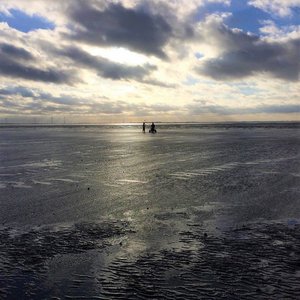During my GSGS Start-up Honours Grant, I carried out a feasibility study at the southern coast of Spiekeroog in order to check if our approach for reconstructing local relative sea-level changes can be applied for the area of the East Frisian Islands, southern North Sea coast. The approach includes studying modern intertidal foraminifer and ostracod associations in combination with elevation measurements as well as environmental parameters (salinity, grain size, pH, C/N- and C/S ratio) in order to establish a sea-level transfer function. The latter will model the relation between the elevation of sample points relative to mean sea level and relative abundances of foraminiferal species over time, whereas Ostracoda provide additional habitat and salinity information. The transfer function will be applied on Holocene sediment cores in order to establish high resolution local relative sea-level reconstructions for the East Frisian Islands.
Within the funded period, I was able to investigate the microfaunal composition and grain-size distribution of first samples from a surface transect reaching from shallow subtidal (tidal flat) to supratidal (salt marsh) areas south of Spiekeroog, which confirm the feasibility of the research approach. Furthermore, I was able to present the idea and first results at the annual conference of the German working group Geography of Coasts and Seas (AMK) in Rostock-Warnemünde in 2016. Microfaunal and sedimentological analyses are still in progress, since, due to the first positive outcome and the great potential of our approach, it could be included into the research project “The Wadden Sea as an archive of landscape evolution, climate change and settlement history” (short WASA). The interdisciplinary research project is funded by the Lower Saxony Ministry for Science and Culture and the Volkswagen Foundation and focuses on identifying and evaluating marine archives in order to reconstruct the environment and development of palaeo-landscapes as well as human activities in the German Wadden Sea region since the last glacial. It provides the opportunity for me to accomplish my PhD. In addition to this research, I was able to submit an article about a former study at the German North Sea coast, which was my Master’s Thesis, to the Journal of Coastal Conservation1. It was accepted in March 2017 and will be published soon.
I would like to thank the GSGS and the steering committee for the generous funding, which paved the way for my future scientific interests to be fulfilled. Furthermore, I owe thanks to Prof. Dr. Helmut Brückner, Dr. Anna Pint, Dr. Peter Frenzel, Dr. Max Engel and Dr. Friederike Bungenstock, who support and supervise me in each possible way with my research.
1 Scheder, J., Engel, M., Bungenstock, F., Pint, A., Siegmüller, A., Schwank, S., Brückner, H., 2017. Fossil bog soils (dwog horizons) and their relation to Holocene coastal changes in the Jade-Weser Region. Journal of Coastal Conservation, DOI: 10.1007/s11852-017-0502-z.
Start-up Honours Grant
Jan to Oct 2016
Juliane Scheder
PhD student
Lower Saxony Institute for Historical Coastal Research, Wilhelmshaven, and
Institute of Geography, University of Cologne
PhD project: “The Wadden Sea as an archive for landscape evolution, climate change and settlement history: Exploration – analysis – predictive modelling” (short: WASA)
Thesis (working title): Holocene relative sea-level reconstructions at the German North Sea coast using microfaunal and sedimentological data
Prof. Dr. Helmut Brückner (working group Geoarchaeology, Coastal Geomorphology and Geochronology)
